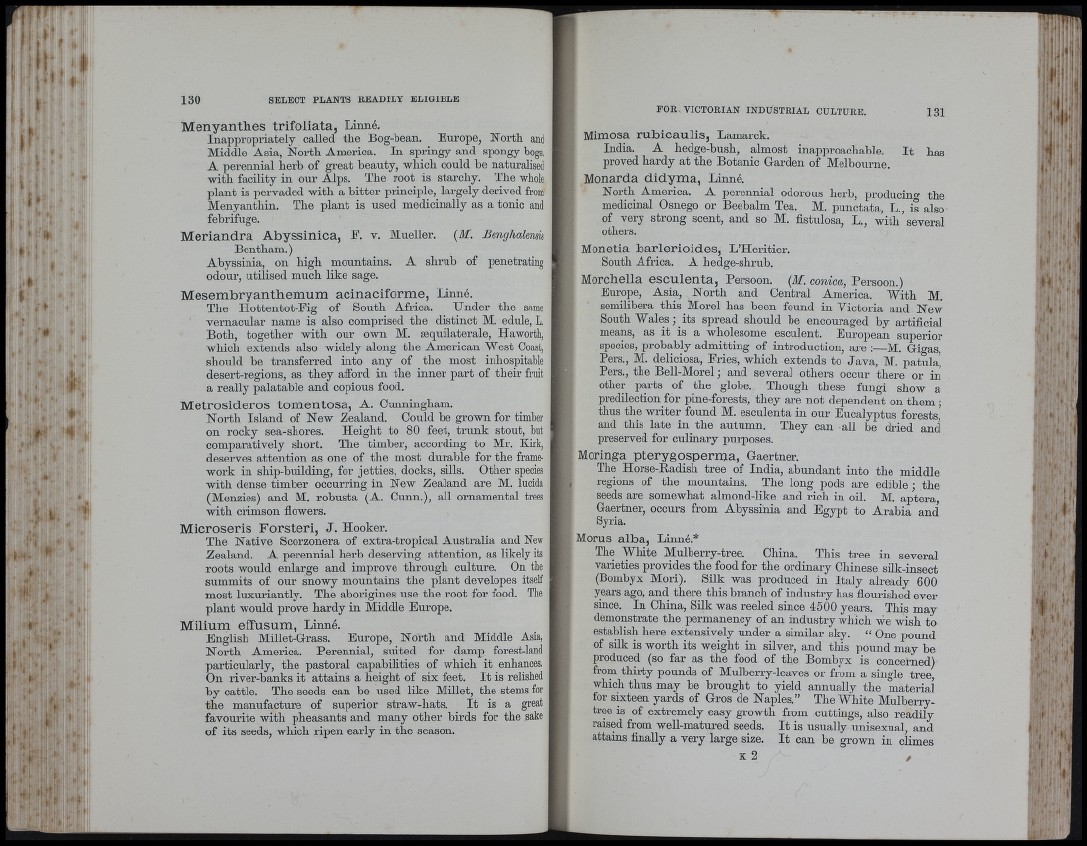
tl
#
Menyanthes trifoliata, Linné.
Inappropriately called the Bog-bean. Europe, North and
Middle Asia, North America. In springy and spongy bogs,
A perennial herb of great beauty, which could be naturalised
with facility in our Alps. Tbe root is starchy. The whole
plant is pervaded with a bitter principle, largely derived from
Menyanthin. Tbe plant is used medicinally as a tonic and
febrifuge.
Meriandra Abyssinica, F. v. Mueller. {M. Benghahnm
Bentham.)
Abyssinia, on high mountains. A slirub of penetrating
odour, utilised much like sage.
Mesembryanthemum acinaciforme, Linné.
The Hottentot-Eig of South Africa. Under the same
vernacular name is also comprised the distinct M. edule, L.
Both, together with our own M. aequilaterale, Haworth,
which extends also widely along the American West Coast,
should be transferred into any of the most inhospitable
desert-regions, as they afford in tbe inner part of tbeir fruit
a really palatable and copious food.
Metrosideros tomentosa, A. Cunningliam.
North Island of New Zealand. Could be grown for timber
on rocky sea-sbores. Height to 80 feet, trunk stout, but
comparatively short. The timber, according to Mr. Kirk,
deserves attention as one of the most dui-able for tbe framework
in ship-building, for jetties, docks, sills. Other species
with dense timber occurring in New Zealand are M. lucida
(Menzies) and M. robusta (A. Cunn.), all ornamental trees
with crimson flowers.
Microseris Forsteri, J . Hooker.
The Native Scorzonera of extra-tropical Australia and New
Zealand. A perennial herb deserving attention, as likely its
roots would enlarge and improve through culture. On the
summits of our snowy mountains the plant developes itself
most luxuriantly. The aborigines use the root for food. The
plant would prove hardy in Middle Europe.
Milium eñusum, Linné.
English Millet-Crass. Europe, North and Middle Asia,
North America. Perennial, suited for damp forest-land
particularly, the pastoral capabilities of which it enhances.
On river-banks it attains a height of six feet. I t is relished
by cattle. The seeds can be used like Millet, the stems for
the manufacture of superior straw-hats. I t is a great
favourite with pheasants and many other birds for the sake
of its seeds, which ripen early in the season.
Mimosa rubicaulis, Lamarck.
India. A hedge-bush, almost inapproachable. I t has
proved hardy at the Botanic Carden of Melbourne.
Monarda didyma, Linné.
North America. A perennial odorous herb, producino- the
medicinal Osnego or Beebalm Tea. M. punctata, L., is also
of very strong scent, and so M. fistulosa, L., with several
others.
Monetia barlerioides, L ’Heritier.
South Africa. A hedge-shrub.
Morchella esculenta, Persoon. {M. cónica, Persoon.)
Europe, Asia, North and Central America. With M.
semilibera this Morel has been found in Victoria and New
South Wales; its spread should be encouraged by artificial
means, as it is a wholesome esculent. European superior
species, probably admitting of introduction, are :—M. Cigas,
Pers., M. deliciosa. Fries, which extends to Java, M. patula’
Pers., the Bell-Morel; and several others occur there or in
other parts of tbe globe. Though these fungi show a
predilection for pine-forests, they are not dependent on them ;
thus the writer found M. escalenta in our Eucalyptus forests’
and this late in the autumn. They can all be dried and
preserved for culinary purposes.
Moringa pterygosperma, Gaertner.
The Horse-Badish tree of India, abundant into the middle
regions of the mountains. The long pods are edible; the
seeds are somewhat almond-like and rich in oil. M. aptera,
Gaertner, occurs from Abyssinia and Egypt to Arabia and
Syria.
Morus alba, Linné.*
The White Mulberry-tree. China. This tree in several
varieties provides the food for the ordinary Chinese silk-insect
(Bomhyx Mori). Silk was produced in Italy already 600
years ago, and there this branch of industry has flourished ever
since. In China, Silk was reeled since 4500 years. This may
demonstrate the permanency of an industry which we wish to
establish here extensively under a similar sky. “ One pound
of silk is worth its weight in silver, and this pound may be
produced (so far as the food of the Bombyx is concerned)
from thirty pounds of Mulberry-leaves or from a single tree,
which thus may be brought to yield annually tbe material
for sixteen yards of Gros de Naples.” The White Mulberry-
tree is of extremely easy growth from cuttings, also readily
raised from well-matured seeds. I t is usually unisexual, and
attains finally a very large size. I t can be grown in climes
K 2 »
■ i i1 ' ii
! '!
It
I <
i;
1^.:, ’ .J